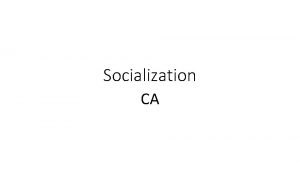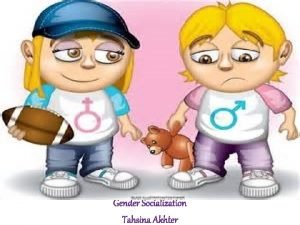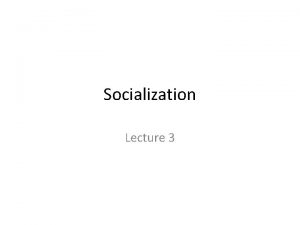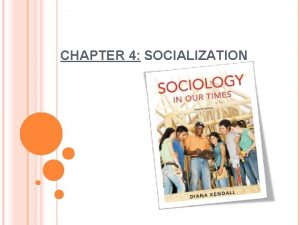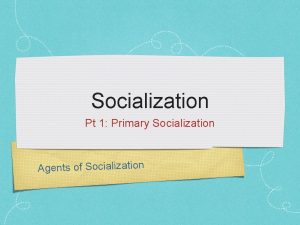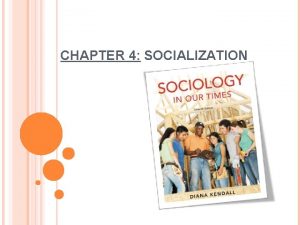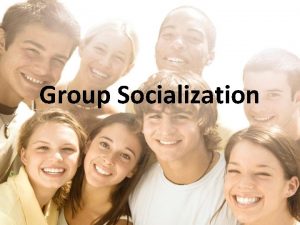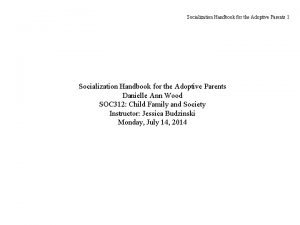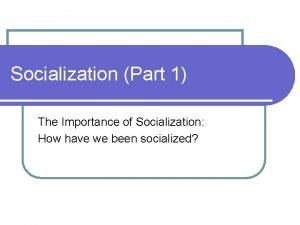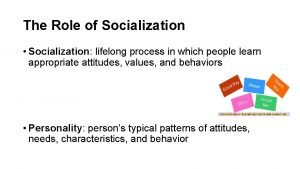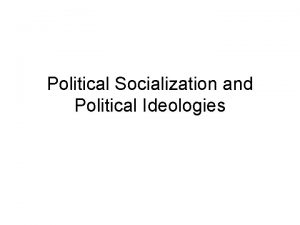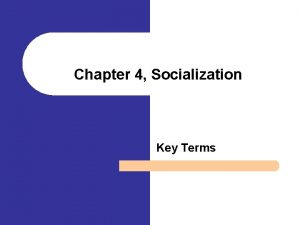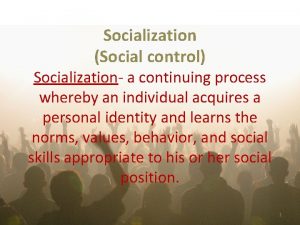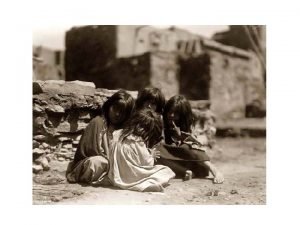Socialization What happens in socialization is that the

























- Slides: 25

Socialization What happens in socialization is that the social world is internalized within the child. The same process, though perhaps weaker in quality, occurs every time the adult is initiated into a new social context or a new social group. Society, then, is not only something “out there, ” in the Durkheimian sense, but it is also “in here, ” part of our innermost being. Peter L. Berger, Invitation to Sociology © Copyright 2010 Alan S. Berger 1

Socialization: The Key to Our Humanity and personality • Socialization is the lifelong social experience by which individuals develop their human potential and learn culture. • Social experience is also the foundation for the personality, a person’s fairly consistent patterns of thinking, feeling, and acting. © Copyright 2010 Alan S. Berger 2

Socialization: The Key to Our Humanity and personality In the nineteenth century there was an intense debate regarding the relative importance of nature (biology) and nurture (socialization) in the shaping of human behavior. Modern sociologists view nurture as much more important than nature in shaping human behavior. Studies of twins (including identical twins) shows that socialization and heredity both contribute to human development The Nature vs Nurture debate continues © Copyright 2010 Alan S. Berger 3

Socialization: The Key to Our Humanity and personality • Research on the effects of social isolation has demonstrated the importance of socialization. All the evidence points to the crucial role in social development in forming personality. • Harry and Margaret Harlow’s experimental work with rhesus monkeys. • Studies of isolated children such as Anna, Isabelle, and Genie © Copyright 2010 Alan S. Berger 4

Creating a sense of self : Cooley • The Self and Socialization • The formation of the self – the set of concepts we use in defining who we are – is a central part of the socialization process. • The self emerges in the course of interaction with other people and represents the ideas we have regarding our attributes, capacities, and behavior. It typically includes an egocentric bias. • Charles Horton Cooley’s notion of the looking-glass self highlights the point of view that our consciousness arises in a social context –, the idea that self-image is based on how others respond to us. © Copyright 2010 Alan S. Berger 5

Creating a sense of self : Mead • George Herbert Mead maintained that we gain a sense of self by acting toward ourselves in much the same fashion that we act toward others. • Mead envisioned this process as a series of stages: In the play stage, the child plays roles modeled on significant others; • followed by the game stage and then the generalized other stage. © Copyright 2010 Alan S. Berger 6

Creating a sense of self : Mead ● The self is a dimension of personality composed of an individual’s self-awareness and self-image. ● It emerges from social experience. ● This social experience is based on the exchange of symbols. ● Understanding someone’s intentions requires imagining the situation from that person’s point of view, a process called taking the role of the other. © Copyright 2010 Alan S. Berger 7

Creating a sense of self : Mead • • The “I” is the self as subject. The “me” is the self as object. The self develops through several stages: Imitation. Play, in which children take the roles of significant others. Games, in which they take the roles of several other people at the same time. Acquisition of the generalized other, defined as widespread cultural norms and values we use as references in evaluating ourselves. © Copyright 2010 Alan S. Berger 8

Creating a sense of self : Mead • He may be criticized for ignoring the role of biology in the development of the self. • Self-image is differentiated from self-conception. Self-esteem is governed by reflected appraisals, social comparisons, and self-attribution. Personal efficacy is another aspect of selfevaluation • Conclusion: Mead showed that symbolic interaction is the foundation of both self and society © Copyright 2010 Alan S. Berger 9

Creating a sense of self : Goffman Erving Goffman emphasized the presentation of self through a process he called impression management; his point of view is embodied in what Goffman called the dramaturgical approach. He studied a series of total institutions starting with a mental hospital © Copyright 2010 Alan S. Berger 10

Creating a sense of self : Goffman • Dramaturgical approach: studies interaction as if we were all actors on a stage • Impression management: altering presentation of self to create distinctive appearances and satisfy particular audiences – Face-work: efforts people make to maintain a proper image and avoid public embarrassment © Copyright 2010 Alan S. Berger 11

Creating a sense of self: Freud Sigmund Freud’s theory of Personality ● The personality is shaped by two opposed forces: eros, the life instinct, and thanatos, the death instinct. ● The personality includes three basic components: The id, the human being’s basic drives. The ego, a person’s conscious efforts to balance innate pleasure-seeking drives with the demands of society. Note who different this is from the contemporary use of “having a big ego” which really means a very positive self image ● The superego, the operation of culture within the individual © Copyright 2010 Alan S. Berger 12

Creating a sense of self: Freud • Freud believed that we internalize norms and his idea that childhood experiences have lasting importance in the socialization process remain critical. Some of his work has been criticized as reflecting a sexist bias. © Copyright 2010 Alan S. Berger 13

Stages of Personality Development : Kai Erickson Stage 1 — Infancy: the challenge of trust (versus mistrust). Stage 2 — Toddlerhood: the challenge of autonomy (versus doubt and shame). Stage 3 — Preschool: the challenge of initiative (versus guilt). Stage 4 — Preadolescence: the challenge of industriousness (versus inferiority). © Copyright 2010 Alan S. Berger 14

Stages of Personality Development : Kai Erickson Stage 5 Adolescence: the challenge of gaining identity (versus confusion) Stage 6 —Young adulthood: the challenge of intimacy (versus isolation). Stage 7 — Middle adulthood: the challenge of making a difference (versus self-absorption). Stage 8 — Old age: the challenge of integrity (versus despair). © Copyright 2010 Alan S. Berger 15

Stages of Personality Development : Jean Piaget • Piaget identified four stages of cognitive development – sensorimotor stage, the level of human development in which individuals experience the world only through sensory contact – preoperational stage, the level of human development in which individuals first use language and other symbols. – concrete operational stage, the level of development at which individuals first perceive causal connections in their surroundings. – formal operational stage, the level of human development at which individuals think abstractly and critically. © Copyright 2010 Alan S. Berger 16

Stages of Personality Development : Jean Piaget • Piaget showed that human beings’ ability to shape their social world unfolds gradually as the result of both biological maturation and social experience. • His theory may not apply to people in a society. © Copyright 2010 Alan S. Berger 17

• Primary interest in Moral development. • Kohlberg suggests that the moral development of children passes through 3 stage • preconventional, • postconventional stages. • Kohlberg’s model presents moral development in distinct stages. • Critique: his theory is based on research using exclusively male subjects. © Copyright 2010 Alan S. Berger 18

Stages of Personality Development : Carol Gilligan • Primary interest: The gender factor • Gilligan found that boys’ moral development reflects a justice model which stresses formal rules, whereas girls put more emphasis on caring and responsibility and less on the rules. • Critique; Gilligan’s work enhances our understanding of gender issues. • However, she does not adequately address the issue of the origin of the gender-based differences that she has identified. © Copyright 2010 Alan S. Berger 19

Socialization and the Life Cycle • Socialization throughout The life cycle – Socialization is a continuing, life-long process. All societies have to deal with the life cycle that begins with conception and ends with death. – Role socialization involves anticipatory socialization, altering roles, and exiting from roles. – The life cycle consists of childhood, adolescence, young adulthood, middle adulthood, later adulthood, and death – Americans are grappling with the issue of euthanasia, and the hospice movement provides a more humane approach to the dying experience. © Copyright 2010 Alan S. Berger 20

Theories of Socialization Erickson • • Resocialization: Total Institutions. – Total institutions are settings in which people are isolated from the rest of society and manipulated by an administrative staff. – Their purpose is resocialization: radically altering an inmate’s personality through deliberate control of the environment. – This is a two-stage process: • The staff breaks down the new inmate’s existing identity. • The staff tries to build a new self. Social interaction is the process by which people act and react in relation to others. Social structure guides human behavior rather than rigidly determining it. © Copyright 2010 Alan S. Berger 21

Socialization and the Life Cycle • And don’t forget the process of socialization into specific institutions such as schools, Jobs, the Military. • Although linked to the biological process of aging, essential characteristics of each stage of the life course are socially constructed. • Each stage presents characteristic problems and transitions that involve learning something new and, in many cases, unlearning what has become familiar. • General patterns relating to age are always modified by social variables such as race and gender. • People’s life experiences vary depending on when they were born. A cohort is a category of people with a common characteristic, usually their age. © Copyright 2010 Alan S. Berger 22

Socialization and the Life Cycle • Childhood became an increasingly separate phase of life with industrialization; it is currently becoming shorter. – Child Labor: Industrialization prolongs childhood and discourages children from work. – Adolescence is often a period of social and emotional turmoil reflecting cultural inconsistency. It is a time of social contradictions when people are no longer children but not yet adults. Like all phases of the life course, it varies with class position. – Adolescence and the Development of Self Among High School Students: Adolescence is a time when people are concerned about identity. Grace Kao documented the importance of racial and ethnic stereotypes in students’ developing sense of self. © Copyright 2010 Alan S. Berger 23

Socialization and the Life Cycle • Adulthood is divided into several stages: – Early adulthood involves working toward goals set earlier in life. – Middle adulthood is characterized by greater reflectiveness. – Old age begins in the mid-sixties. The U. S. is currently experiencing an increase in the elderly population. © Copyright 2010 Alan S. Berger 24

Socialization and the Life Cycle • Death and Dying • Elisabeth Kübler-Ross identifies five stages in coming to accept death: • • • denial, anger, negotiation, resignation acceptance. • Today fear and anxiety about death are common, but greater acceptance is likely in the future. © Copyright 2010 Alan S. Berger 25
 Walmart thất bại ở nhật
Walmart thất bại ở nhật Gây tê cơ vuông thắt lưng
Gây tê cơ vuông thắt lưng Block xoang nhĩ là gì
Block xoang nhĩ là gì Tìm độ lớn thật của tam giác abc
Tìm độ lớn thật của tam giác abc Sau thất bại ở hồ điển triệt
Sau thất bại ở hồ điển triệt Thể thơ truyền thống
Thể thơ truyền thống Con hãy đưa tay khi thấy người vấp ngã
Con hãy đưa tay khi thấy người vấp ngã Thơ thất ngôn tứ tuyệt đường luật
Thơ thất ngôn tứ tuyệt đường luật Tôn thất thuyết là ai
Tôn thất thuyết là ai Phân độ lown ngoại tâm thu
Phân độ lown ngoại tâm thu Làm thế nào để 102-1=99
Làm thế nào để 102-1=99 Chúa yêu trần thế alleluia
Chúa yêu trần thế alleluia Thiếu nhi thế giới liên hoan
Thiếu nhi thế giới liên hoan Khi nào hổ con có thể sống độc lập
Khi nào hổ con có thể sống độc lập điện thế nghỉ
điện thế nghỉ Biện pháp chống mỏi cơ
Biện pháp chống mỏi cơ Một số thể thơ truyền thống
Một số thể thơ truyền thống Cong thức tính động năng
Cong thức tính động năng Các số nguyên tố
Các số nguyên tố Bổ thể
Bổ thể Vẽ hình chiếu vuông góc của vật thể sau
Vẽ hình chiếu vuông góc của vật thể sau Phản ứng thế ankan
Phản ứng thế ankan Các môn thể thao bắt đầu bằng tiếng đua
Các môn thể thao bắt đầu bằng tiếng đua Sơ đồ cơ thể người
Sơ đồ cơ thể người Tư thế ngồi viết
Tư thế ngồi viết đặc điểm cơ thể của người tối cổ
đặc điểm cơ thể của người tối cổ


























